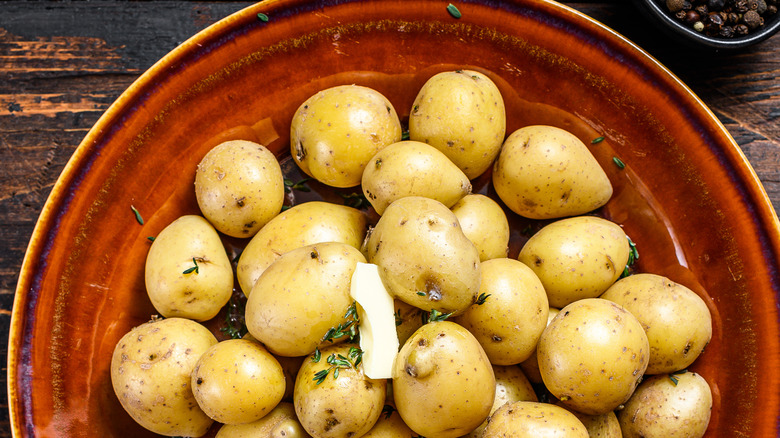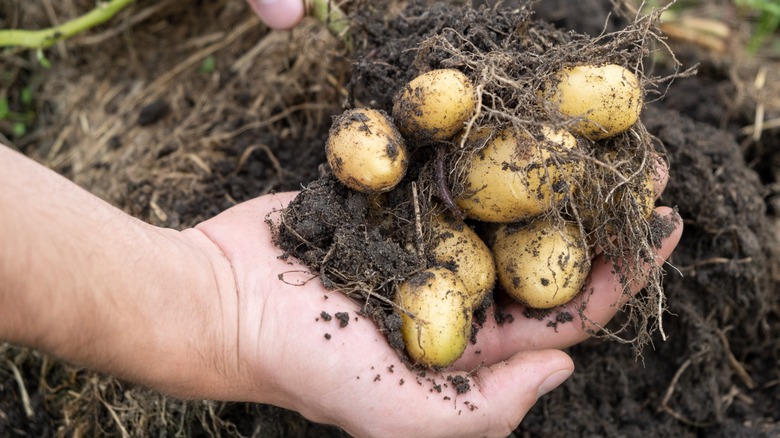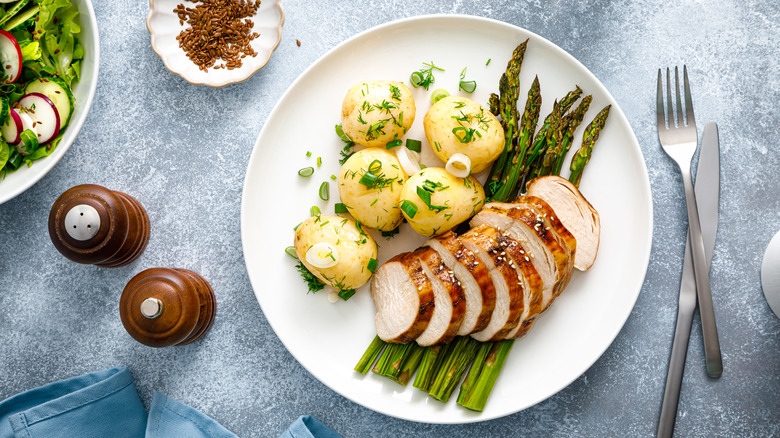The Unique Flavor That Sets 'New' Potatoes Apart
Americans love to eat tiny fruits and vegetables. What started out as an obsession with baby carrots (according to The Atlantic) has become an affinity for all kinds of other young, early-harvest, or "baby" produce, from beets to bok choy, cauliflower to corn. But while the produce section is filled with the latest in little lettuces and miniature melons, the fascination with baby veggies has roots as far back as the late 1800s (per Slate).
Some tiny fruits and vegetables are varieties that were bred to be fully mature even with they're small, like gherkin cucumbers meant for pickling French cornichons, while many others are simply harvested before they're mature, as in the case of microgreens and thin-skinned squashes like zucchini and patty pans. The thought process for harvesting baby vegetables is that they'll be more tender and delicate than their full-grown counterparts, and one of the best examples of this is new potatoes.
New potatoes are often confused with other kinds of small spuds, like fingerlings. However, new potatoes can actually be any variety of potato, they're just harvested early — usually within 60 to 90 days of planting (per The Press-Enterprise) or within a few days or weeks of the time that the plant starts to flower. Farmers dig up these early tubers to thin out the crop and make space for the remaining potatoes to grow into full size.
New potatoes differ from regular potatoes in taste and skin texture
Since they aren't fully grown, new potatoes have a higher water content and are less starchy than mature potatoes, as the sugars haven't converted to starch (per All About Potatoes). This makes the flesh of new potatoes very creamy and sweet tasting, which is perfect for a variety of delicate and elegant recipes (per Masterclass).
In the United States and other countries in the northern hemisphere, shop for new potatoes in farmer's markets and specialty grocery stores between April and July (per BBC GoodFood), and look for tubers that are dry and firm. It's ok if they still have dirt on them; because they are immature, baby potatoes need to be treated with a little extra TLC. While regular potatoes can endure some wear and tear thanks to their tough exteriors (perfect for potato skins), the skin on new potatoes is very thin and fragile and can even be scratched away if you scrub them too hard when you clean off any lingering dirt. When you get the potatoes home, gently wipe away the extra dirt and then give them a rinse. They're much more perishable than full-grown potatoes, so if you pick up a bag or two at the market, be prepared either to use them right away or to store them in a well-ventilated place for a day or two, such as loosely stowed in a paper bag.
Cooking new potatoes
New potatoes can be used in any recipe that calls for regular potatoes. Because their skins are so thin, you don't need to peel them before cooking. To play up the natural sweet, fresh taste of these seasonal specialties, gently simmer them whole (skins on) in a court bouillon of vegetables and herbs and serve them as the star of the show in a classic salade Niçoise, or gently smash them and mix with a little dill vinaigrette for a springy potato salad.
If you like a little crunch, the skins of new potatoes roast very nicely. Depending on their size, which should be around 1.5 to 2.5 inches according to Agrow Fresh, they can be roasted whole (no knives required), or you can squish them after poaching for crispy smashed potatoes. Toss them in a little bit of high-quality olive oil and add salt and pepper and some potato-friendly herbs and spices and roast them in a hot oven for an easy, elegant side dish. If you want to get the skins extra crispy, you could also try using Chef Dan Kluger's method of tossing them in whipped egg whites before seasoning them and putting them in the oven.


